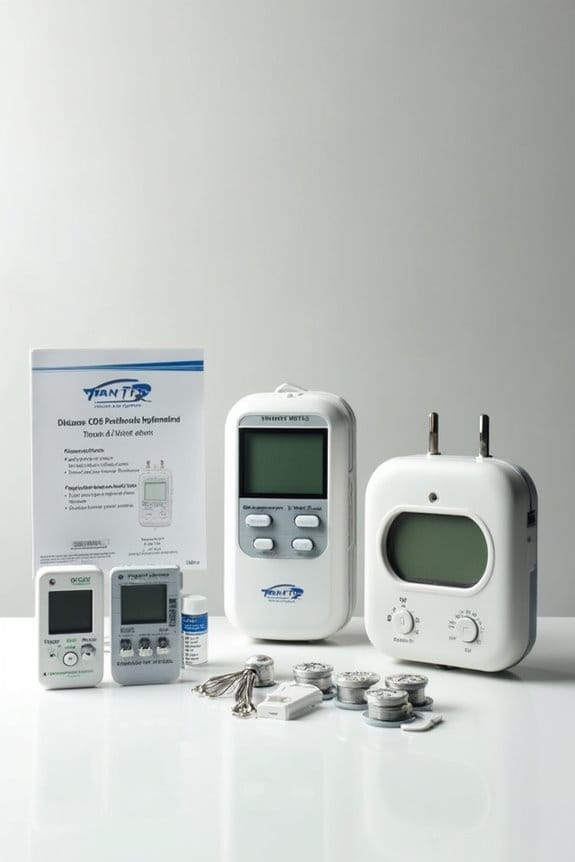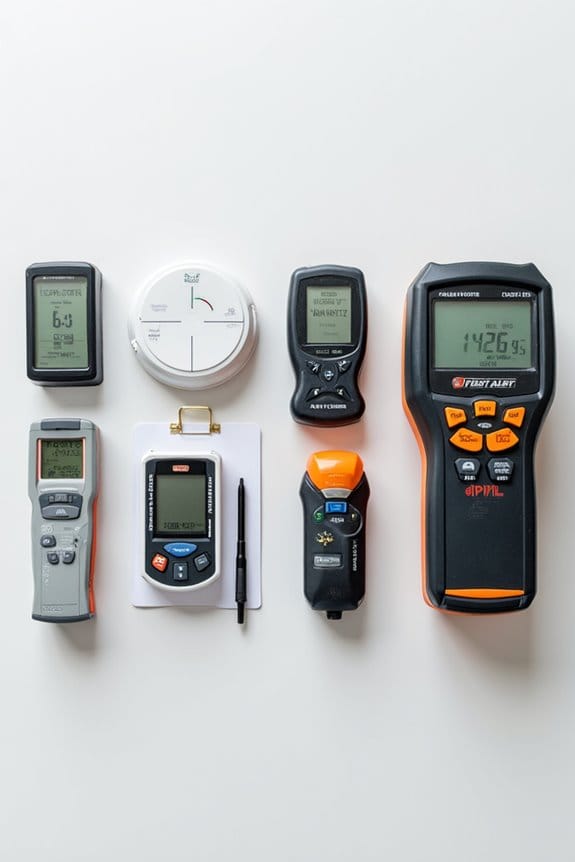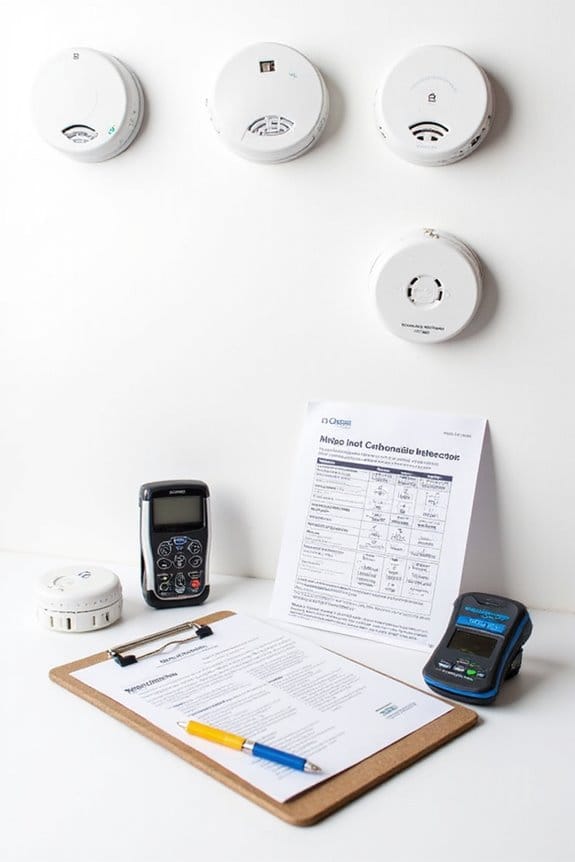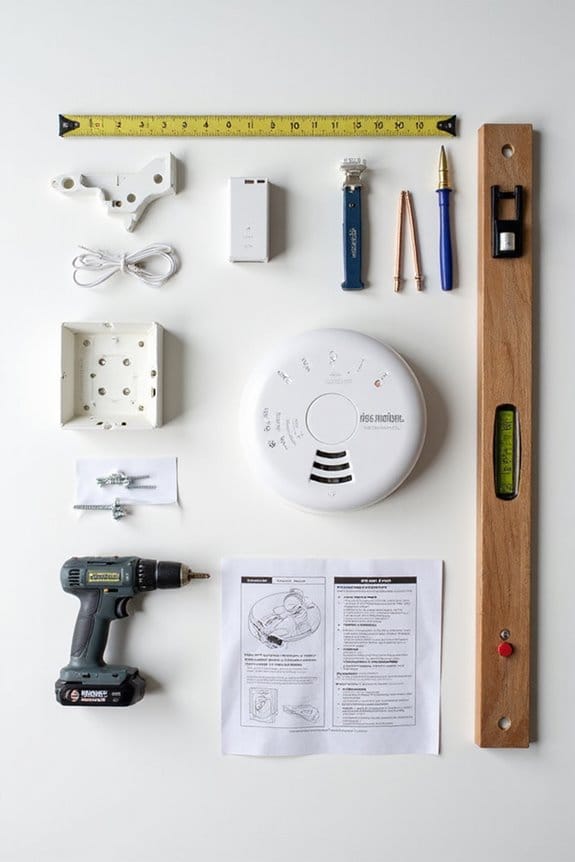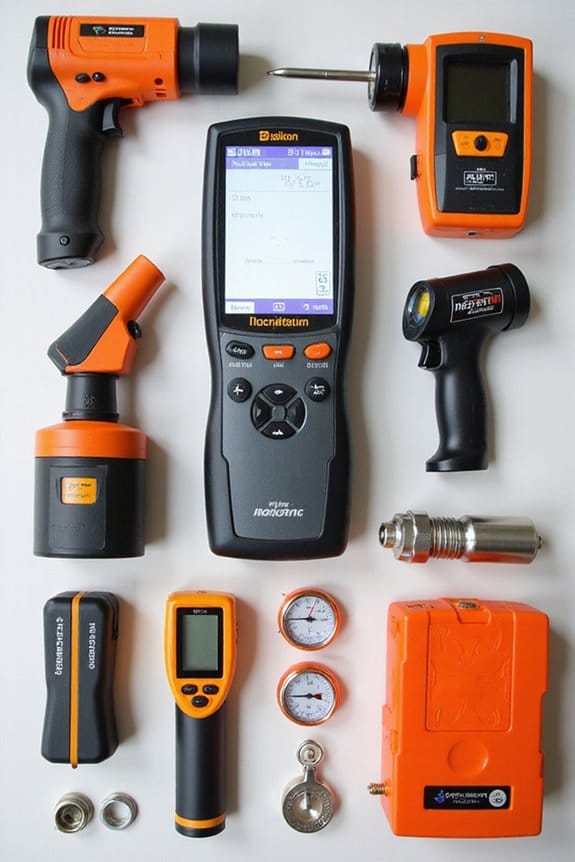Alright, here’s the scoop on CO alarms versus detectors. First, CO alarms sound a loud alert when dangerous levels of carbon monoxide are detected—immediate danger, you know? On the flip side, CO detectors continuously monitor those levels and often show real-time data. While alarms are your emergency sirens, detectors keep you informed. Don’t forget the placement and power source matters too! Stick around if you want to know more about sensor tech and installation tips!
Key Takeaways
- CO alarms provide immediate alerts with a loud sound when dangerous CO levels are detected, while CO detectors continuously monitor and display CO levels.
- Alarms are designed solely for immediate danger warnings, whereas detectors also track real-time CO concentrations and may offer voice alerts.
- CO alarms and detectors differ in installation; alarms should be mounted at eye level, while detectors can be placed in various locations for monitoring.
- CO alarms typically beep four times for danger, while detectors may include multiple alarm levels for different CO concentrations.
- Regulatory standards vary: CO alarms must meet UL 2034, while detectors are governed by ANSI/UL 2075 for sensor performance.
Definition and Purpose

- Carbon Monoxide Alarms: These handy gadgets are designed to sound an alarm when they detect dangerous levels of CO gas. They’re essential for keeping your home safe from this silent killer.
- Purpose: The main purpose of CO alarms is to provide immediate warnings. They alert you when CO levels become dangerous, giving you precious time to react.
- CO Alarm Features: Look for features like battery power or hardwired options, and remember that they meet UL 2034 standards. Additionally, many models come equipped with digital displays that show real-time CO levels for enhanced safety awareness.
- CO Detector Types: On the other hand, CO detectors might not sound an alarm. They primarily track CO levels and can integrate into larger safety systems.
In short, if you want peace of mind, go for a CO alarm!
Functional Differences

When it comes to understanding the functional differences between CO alarms and detectors, it’s essential to know what sets them apart. Here’s a quick breakdown:
- Alert Type: CO alarms sound a loud alert when dangerous levels are detected, while detectors provide continuous monitoring and may even show CO levels on a display.
- Sensor Maintenance: CO detectors often use electrochemical sensors, which have better detection reliability and can last 5-10 years. They require less maintenance than some other sensors.
- Information Provided: Detectors can offer real-time data and sometimes voice alerts, while alarms focus solely on immediate dangers.
In short, if you want ongoing peace of mind, a CO detector might be the way to go!
Installation and Power

Understanding how to properly install and power your CO alarms and detectors is just as important as knowing their functional differences. Here’s what I’ve learned about the installation options and power sources:
- Installation Height: Mount your alarms at eye level (1.5 to 1.7 meters) on walls, not ceilings. CO gas behaves like air!
- Placement: Keep them 1 to 3 meters from fuel-burning appliances and in sleeping areas for maximum coverage.
- Power Sources: Choose from plug-in models with battery backups, hardwired systems, or battery-operated alarms. Battery-powered ones are super easy to install—just mount and go!
- Backup Options: Always check for battery life; some last up to 10 years!
With these tips, you’ll have peace of mind knowing your CO detectors are set up right.
Alarm and Notification

While knowing how to install CO alarms and detectors is essential, understanding their alarm and notification systems is just as crucial for your safety. Here’s a quick rundown of what you need to know:
- Alarm Sounds: CO alarms beep four times continuously, while smoke alarms emit three rapid beeps. A single chirp usually means it’s time for a battery change.
- Notification Types: Some modern alarms feature voice alerts for clearer instructions, and there are visual options like strobe lights for those with hearing impairments.
- Maintenance Signals: Regular testing and timely battery replacements help keep your alarms functioning properly. Additionally, detectors often include multiple alarm levels for different CO concentrations to ensure effective notifications of any potential danger.
Sensor Technology

We’ve covered the basics of alarm systems, but now it’s time to explore the heart of these devices: sensor technology. Here’s a quick look at the primary sensor types and their detection methods:
- Electrochemical Sensors: These are the gold standard. They’re super sensitive to low CO levels and handle humidity well, so false alarms are minimized.
- Metal Oxide Semiconductor (MOS) Sensors: These are budget-friendly but may trigger false alarms due to environmental factors. Great for portable detectors, though!
- Biomimetic Sensors: These use a color change to detect CO and are energy-efficient. Not as common, but clever!
Regulatory and Safety Standards
When it comes to CO alarms and detectors, knowing the regulatory and safety standards is essential for keeping your home safe. Here’s a quick rundown:
- UL 2034 Compliance: CO alarms need to meet this standard for sensitivity and alarm thresholds.
- ANSI/UL 2075: This applies to CO detection sensors and includes performance testing.
- Alarm Thresholds: Alarms trigger at various CO levels—70 ppm in 1-4 hours, and 400 ppm in just 4-15 minutes. That’s fast!
Importance of Proper Placement
Proper placement of carbon monoxide (CO) alarms is critical for your safety and peace of mind. Here are some placement guidelines I recommend for effective installation:
- Every Floor: Install an alarm on each level of your home, including basements and attics.
- Near Bedrooms: Place detectors within 10 feet of bedroom doors to guarantee you hear alerts at night.
- Avoid False Alarms: Keep alarms at least 5 to 10 feet away from fuel-burning appliances.
- Height Matters: Mount detectors about 5 feet above the floor for best detection.
- Airflow Issues: Don’t position alarms near vents or in humid areas like bathrooms.
Following these guidelines not only enhances safety but also helps avoid those pesky false alarms! Additionally, using detectors with advanced sensing technology can further reduce the chances of false alarms triggered by common household activities.
Combination Units and Their Benefits
While it might seem tempting to install separate smoke and carbon monoxide detectors, combination units offer a smarter solution that saves you time and space. Here are some combination benefits that might just convince you:
- Dual Protection: These units catch both smoke and CO in one device, covering two major threats.
- Installation Efficiency: You only need to install one unit, which cuts down on time and clutter.
- Cost-Effective Maintenance: Forget juggling batteries for two alarms; one device means simpler upkeep.
- Aesthetic Appeal: With fewer devices, your walls look cleaner and more modern.
Additionally, many combination units feature advanced electrochemical sensors for accurate detection of both threats, enhancing your home’s safety. Trust me, combination units are a practical choice that enhances your home’s safety without overwhelming your space. Plus, who doesn’t love fewer things to manage?
Frequently Asked Questions
How Often Should I Replace My CO Alarm or Detector?
I replace my CO alarm every 5 to 7 years, as recommended. Understanding replacement frequency is essential for safety; even with new batteries, the alarm’s lifespan can diminish, leading to potential risks if ignored.
Can CO Alarms Be Installed Outside the Home?
I remember my grandmother’s warnings about safety. Unfortunately, CO alarms shouldn’t be installed outdoors due to safety concerns. They’re designed for indoor use, where they can effectively detect dangerous gas and protect us.
What Should I Do if My CO Alarm Goes Off?
If my CO alarm goes off, I immediately evacuate everyone and call emergency services. After ensuring safety, I focus on alarm testing and ventilation, never ignoring the urgency of the situation. Safety comes first!
Are There Any Specific Brands Recommended for CO Alarms?
When choosing CO alarms, I recommend trusted brands like Nest, First Alert, and Kidde. They offer top features like digital displays, reliable sensors, and various power options, ensuring safety and peace of mind in my home.
Do CO Detectors Require Regular Maintenance or Servicing?
Think of your CO detector as a vigilant guardian. I believe regular CO detector maintenance is essential; it not only prolongs its lifespan but also protects us from the silent threat of carbon monoxide. Stay safe!

